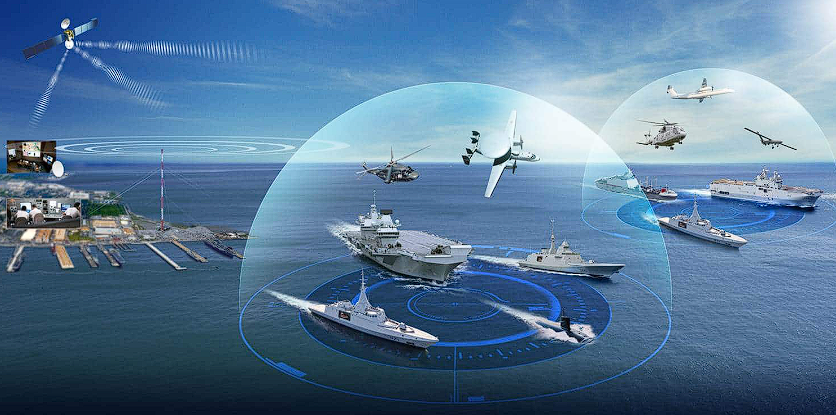
INTRODUCTION:
Electronic Warfare (EW) encompasses the use of electronic signals such as radar, utilizing radio or infrared waves to detect, interpret, or manipulate enemy signals to protect military assets. It is a pivotal element of modern warfare, ensuring the security of military communications and enhancing the effectiveness of defense strategies.
1.1 Electronic Warfare Categories
1.1.1 Electronic Support Measures (ESM):
Electronic Support Measures (ESM) involve passive electronic surveillance and reconnaissance actions aimed at searching for, intercepting, locating, recording, and analyzing radiated electromagnetic energy to gather intelligence and support military operations. ESM systems are designed to detect and analyze enemy electronic emissions, including radar signals, communications transmissions, and other electromagnetic activities. By collecting and processing electronic signals, ESM systems provide situational awareness, detect threats, and gather intelligence on enemy activities across the electromagnetic spectrum.
1.1.2 Electronic Counter Measures (ECM):
Electronic Countermeasures (ECM) encompass active measures aimed at preventing or reducing the enemy’s effective use of the electromagnetic spectrum. ECM involves actions such as jamming radar signals, deceiving enemy sensors, and disrupting communications. ECM systems generate electronic signals to interfere with or neutralize enemy electronic capabilities, thereby degrading their ability to communicate, target, or navigate effectively. The purpose of ECM is to disrupt, deceive, or deny the enemy’s electronic systems, ultimately enhancing the survivability and effectiveness of friendly forces.
1.1.3 Electronic Counter-Counter Measures (ECCM):
Electronic Counter-Countermeasures (ECCM) are measures taken to counter the effects of enemy electronic countermeasures. ECCM focuses on protecting friendly electronic systems from enemy ECM actions and ensuring their continued effectiveness in the face of electronic threats. ECCM techniques include signal processing enhancements, frequency hopping, spread spectrum techniques, and other methods to mitigate the impact of enemy jamming, deception, or interference. The purpose of ECCM is to maintain the operational integrity of friendly electronic systems and to counteract the disruptive effects of enemy ECM, thereby enhancing the overall effectiveness of military operations.
1.2 Electronic Warfare Platforms
1.2.1 Naval EW system:
Warships equipped with advanced electronic warfare systems are designed to detect, analyze, and counter enemy electronic threats at sea, including radar jamming, electronic surveillance, and anti-ship missile defense. These warships play a crucial role in enhancing the survivability of naval fleets by providing early warning against electronic threats and effectively countering them. Similarly, submarines with EW Systems installed, will enhance their stealth capabilities and counter hostile sensors and communications.
1.2.2 Airborne EW system:
Aircraft are dedicated platforms equipped with electronic warfare systems for airborne operations, including signal intelligence (SIGINT), electronic support measures (ESM), and electronic countermeasures (ECM). Specialized aircraft that are used for spying play a vital role in detecting, analyzing, and countering enemy electronic threats during military operations, providing crucial support to ground and naval forces. Also, Externally mounted electronic pods on aircraft will enhance their cyber capabilities. These pods contain various EW systems, including radar jamming, and electronic surveillance devices.By deploying EW pods, aircraft can effectively detect and neutralize enemy electronic threats, significantly enhancing their survivability during missions.
1.2.3 Ground-based :
Ground vehicles equipped with electronic warfare systems designed for electronic surveillance, jamming, and protection of ground forces against enemies, play a crucial role in providing real-time data of enemies such as location, and interceptions to the ground forces, used for monitoring, and analyzing enemy electronic emissions in a specific area, enhancing their situational awareness and attack plans on the battlefield.
EW Stations are either fixed or mobile ground stations; these stations serve as key assets for gathering electronic intelligence, detecting enemy activities, and providing early warning against electronic threats. Together, EW Vehicles and EW Stations form an integral part of the ground-based electronic warfare system, ensuring the effective protection of ground forces in critical combat scenarios.
1.2.4 Cyber EW system
Cyber Warfare Tools are software and systems utilized for electronic warfare operations in cyberspace. These tools enable activities such as network intrusion, electronic deception, and information warfare tactics. They are designed to disrupt, deceive, or exploit enemy networks and systems, aiming to gain a strategic advantage in the cyber domain. Cyber Defense Systems encompass technologies and platforms specifically engineered to safeguard military networks and systems from cyber threats and attacks. By employing advanced cybersecurity measures, these defense systems play a vital role in protecting against cyber incursions and maintaining operational readiness in the face of evolving cyber threats.
1.2.5 Satellite-based EW system:
EW Satellites are specialized satellites equipped with electronic intelligence (ELINT) and signal interception capabilities. These satellites are designed to gather intelligence on enemy electronic activities from space, providing valuable insights into adversary communications, radar systems, and electronic emissions. By monitoring and intercepting signals from orbit, EW satellites contribute to situational awareness and intelligence gathering in electronic warfare operations.
1.3 Importance of EW technology
Military-graded electronic devices are crucial in protecting the flow of information between combat systems and military officials. The importance of EW technology lies in its capacity to offer a decisive advantage in modern warfare scenarios through intelligence gathering, force protection, disruption of enemy capabilities, and resilience against electronic and cyber threats. As electronic warfare continues to evolve, advanced EW technology remains indispensable for maintaining military superiority and achieving mission success.
INDIAN ELECTRONIC WARFARE PROJECTS:
2.1 Integrated Electronic Warfare Programme (IEWS):
The Integrated Electronic Warfare System (IEWS) is a comprehensive program aimed at enhancing the electronic warfare capabilities of a military force by integrating various electronic warfare systems and technologies into a unified system. This program focuses on improving the coordination and effectiveness of electronic support measures (ESM), electronic countermeasures (ECM), and electronic counter-countermeasures (ECCM) to achieve superiority in the electromagnetic spectrum.
The IEWS aims to provide a holistic approach to electronic warfare by combining different subsystems and technologies to create a more robust and versatile electronic warfare capability. By integrating various electronic warfare components, such as radar jamming, signal intelligence, and electronic attack systems, the IEWS seeks to enhance the military’s ability to detect, identify, and counter enemy electronic threats effectively.
Furthermore, the IEWS emphasizes the importance of utilizing modern computer equipment to assist in complex battle operations, reflecting the evolving nature of electronic warfare and the need for sophisticated technology to stay ahead in this domain. Overall, the Integrated Electronic Warfare System (IEWS) represents a strategic initiative to consolidate and optimize electronic warfare capabilities to ensure operational success in modern conflicts.
2.2 Netra V2 Airborne Early Warning and Control (AEW&C) System:
This is an advanced surveillance system developed by India. Mounted on an Embraer EMB-145 aircraft platform, it features a powerful AESA radar providing 360-degree coverage for detecting and tracking multiple airborne and surface targets simultaneously. The system facilitates command, control, and communication functions, serving as a communication relay hub and providing real-time situational awareness to ground-based and naval units. With its long endurance capability, the Netra V2 AEW&C System significantly enhances India’s airborne surveillance and reconnaissance capabilities, contributing to improved national security.
2.3 Samyukta Electronic Warfare System:
The Samyukta Electronic Warfare System was developed in India to enhance its electronic warfare capabilities.It integrates various subsystems and technologies to create a versatile and effective electronic warfare platform. It is equipped with advanced features such as radar jamming, signal intelligence, electronic attack capabilities, and other electronic warfare functionalities to detect, identify, and counter enemy electronic threats. By leveraging the capabilities of the Samyukta Electronic Warfare System, the Indian Armed Forces can effectively neutralize enemy electronic systems, disrupt communications, and protect their electronic assets. Thus, it represents a significant advancement in India’s electronic warfare capabilities, showcasing the country’s commitment to developing robust defense technologies to safeguard its national security interests.
DEVELOPMENT IN INDIAN ELECTRONIC WARFARE SYSTEM:
Year: 2014 – DRDO announces the development of next-generation EW systems for UAVs, aircraft, and satellites.
[Source: Deccan Herald – “India plans to develop next-gen electronic warfare systems”]
Year: 2015 – BEL (Bharat Electronics Limited) plans to install coastal surveillance stations with EW capabilities.
[Source: Deccan Herald – “India plans to develop next-gen electronic warfare systems”]
Year: 2018 – Induction of indigenous Electronic Warfare systems like Samyukta into the Indian Army
[Source: Various news reports on DRDO and Indian Army]
Year: 2021 – DRDO successfully tests Shakti Electronic Warfare suite for fighter jets [Source: News reports on DRDO’s Shakti program]
Year: 2023 – Contract awarded to BEL for procurement of Him Shakti Integrated Electronic Warfare Systems
[Source: News reports on Him Shakti EW system]
KEY ELECTRONIC WARFARE DEVICES AND INNOVATIONS OF INDIA:
3.1 Samyukta:
3.2 Sangraha:
3.3 Divya Drishti:
PERFORMANCE OF INDIAN EW DEVICES:
It is challenging to detail specific instances of successful EW operations due to the classified nature of military operations. However, the strategic importance and continued development of these systems indicate a robust capability to counteract various electronic threats. It’s essential to note that the effectiveness and success of EW systems are often not publicly disclosed due to security reasons.
CYBER WARFARE Vs ELECTRONIC WARFARE:
Cyber warfare involves attacking or defending information systems through cyberspace, which includes computers and network operations. Electronic warfare, however, specifically targets the electromagnetic spectrum, focusing on signal intelligence and disruption.
CYBER WARFARE IN THE CONTEXT OF LAND WARFARE:
In land warfare, cyber capabilities can disrupt enemy communications, logistics, and command and control systems directly through network intrusions, significantly impacting their operational capabilities.
CYBER WARFARE AND ELECTRONIC WARFARE: A PLA VIEW
The People’s Liberation Army (PLA) of China views cyber warfare and electronic warfare as integrated components of its military strategy, emphasizing the need to dominate both cyber and electromagnetic spheres to achieve battlefield superiority.
CYBER WARFARE AND ELECTRONIC WARFARE: INDIA’S VIEW
India recognizes the overlapping domains of cyber and electronic warfare as vital to modern military strategy. By developing both capabilities, India aims to ensure a comprehensive defense posture that addresses all dimensions of digital and electromagnetic threats.
CONCLUSION:
India must prioritize increasing budget allocations for R&D in new and advanced EW systems, also to support studies in military-graded electronic devices and radar technologies. By prioritizing research and development, along with continuous improvements and modernization of electronic warfare capabilities, India can build a robust workforce of skilled professionals dedicated to advancing these vital systems. The integration of Artificial Intelligence and Machine Learningtechnologies into these systems will further enhance their effectiveness and efficiency. Strengthening the electronic and cyber warfare capabilities is crucial for India to protect the defense infrastructure and formidable player in international security arenas. This strategic focus on electronic and cyber warfare is vital for maintaining national sovereignty and regional stability amid changing global threats.
Author: Srihari Alangaraj
Research Assistant
BE Mechanical Engineering

